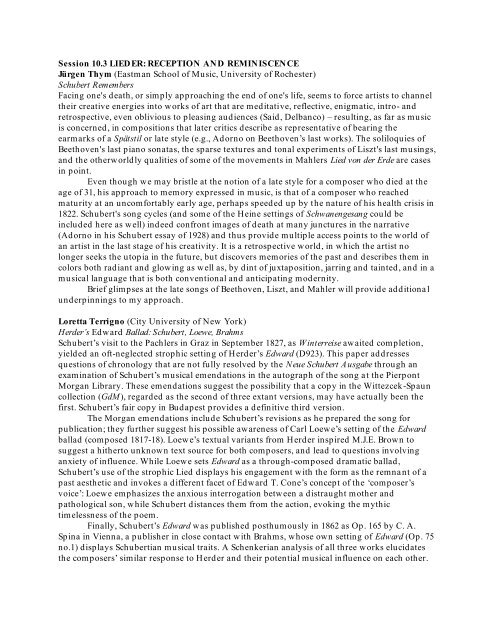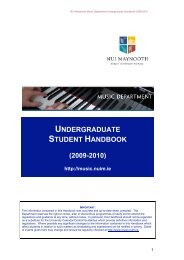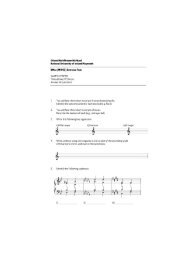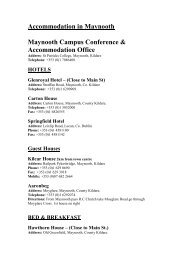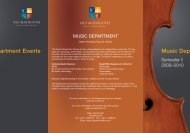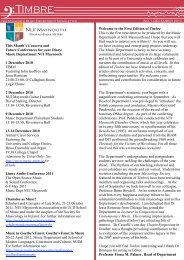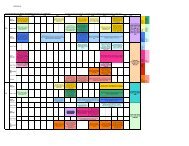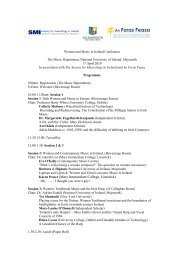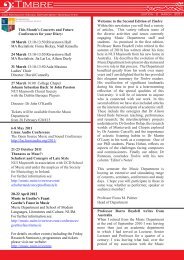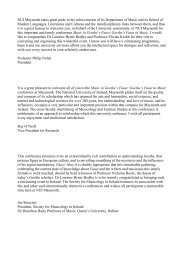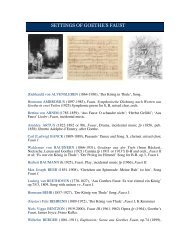Conference Booklet - Music - National University of Ireland, Maynooth
Conference Booklet - Music - National University of Ireland, Maynooth
Conference Booklet - Music - National University of Ireland, Maynooth
You also want an ePaper? Increase the reach of your titles
YUMPU automatically turns print PDFs into web optimized ePapers that Google loves.
Session 10.3 LIEDER: RECEPTION AND REMINISCENCE<br />
Jürgen Thym (Eastman School <strong>of</strong> <strong>Music</strong>, <strong>University</strong> <strong>of</strong> Rochester)<br />
Schubert Remembers<br />
Facing one's death, or simply approaching the end <strong>of</strong> one's life, seems to force artists to channel<br />
their creative energies into works <strong>of</strong> art that are meditative, reflective, enigmatic, intro- and<br />
retrospective, even oblivious to pleasing audiences (Said, Delbanco) – resulting, as far as music<br />
is concerned, in compositions that later critics describe as representative <strong>of</strong> bearing the<br />
earmarks <strong>of</strong> a Spätstil or late style (e.g., Adorno on Beethoven‘s last works). The soliloquies <strong>of</strong><br />
Beethoven's last piano sonatas, the sparse textures and tonal experiments <strong>of</strong> Liszt's last musings,<br />
and the otherworldly qualities <strong>of</strong> some <strong>of</strong> the movements in Mahlers Lied von der Erde are cases<br />
in point.<br />
Even though we may bristle at the notion <strong>of</strong> a late style for a composer who died at the<br />
age <strong>of</strong> 31, his approach to memory expressed in music, is that <strong>of</strong> a composer who reached<br />
maturity at an uncomfortably early age, perhaps speeded up by the nature <strong>of</strong> his health crisis in<br />
1822. Schubert's song cycles (and some <strong>of</strong> the Heine settings <strong>of</strong> Schwanengesang could be<br />
included here as well) indeed confront images <strong>of</strong> death at many junctures in the narrative<br />
(Adorno in his Schubert essay <strong>of</strong> 1928) and thus provide multiple access points to the world <strong>of</strong><br />
an artist in the last stage <strong>of</strong> his creativity. It is a retrospective world, in which the artist no<br />
longer seeks the utopia in the future, but discovers memories <strong>of</strong> the past and describes them in<br />
colors both radiant and glowing as well as, by dint <strong>of</strong> juxtaposition, jarring and tainted, and in a<br />
musical language that is both conventional and anticipating modernity.<br />
Brief glimpses at the late songs <strong>of</strong> Beethoven, Liszt, and Mahler will provide additiona l<br />
underpinnings to my approach.<br />
Loretta Terrigno (City <strong>University</strong> <strong>of</strong> New York)<br />
Herder’s Edward Ballad: Schubert, Loewe, Brahms<br />
Schubert‘s visit to the Pachlers in Graz in September 1827, as Winterreise awaited completion,<br />
yielded an <strong>of</strong>t-neglected strophic setting <strong>of</strong> Herder‘s Edward (D923). This paper addresses<br />
questions <strong>of</strong> chronology that are not fully resolved by the Neue Schubert Ausgabe through an<br />
examination <strong>of</strong> Schubert‘s musical emendations in the autograph <strong>of</strong> the song a t the Pierpont<br />
Morgan Library. These emendations suggest the possibility that a copy in the Wittezcek-Spaun<br />
collection (GdM), regarded as the second <strong>of</strong> three extant versions, may have actually been the<br />
first. Schubert‘s fair copy in Budapest provides a definitive third version.<br />
The Morgan emendations include Schubert‘s revisions as he prepared the song for<br />
publication; they further suggest his possible awareness <strong>of</strong> Carl Loewe‘s setting <strong>of</strong> the Edward<br />
ballad (composed 1817-18). Loewe‘s textual variants from Herder inspired M.J.E. Brown to<br />
suggest a hitherto unknown text source for both composers, and lead to questions involving<br />
anxiety <strong>of</strong> influence. While Loewe sets Edward as a through-composed dramatic ballad,<br />
Schubert‘s use <strong>of</strong> the strophic Lied displays his engagement with the form as the remna nt <strong>of</strong> a<br />
past aesthetic and invokes a different facet <strong>of</strong> Edward T. Cone‘s concept <strong>of</strong> the ‗composer‘s<br />
voice‘: Loewe emphasizes the anxious interrogation between a distraught mother and<br />
pathological son, while Schubert distances them from the action, evoking the mythic<br />
timelessness <strong>of</strong> the poem.<br />
Finally, Schubert‘s Edward was published posthumously in 1862 as Op. 165 by C. A.<br />
Spina in Vienna, a publisher in close contact with Brahms, whose own setting <strong>of</strong> Edward (Op. 75<br />
no.1) displays Schubertian musical traits. A Schenkerian analysis <strong>of</strong> all three works elucidates<br />
the composers‘ similar response to Herder and their potential musical influence on each other.


